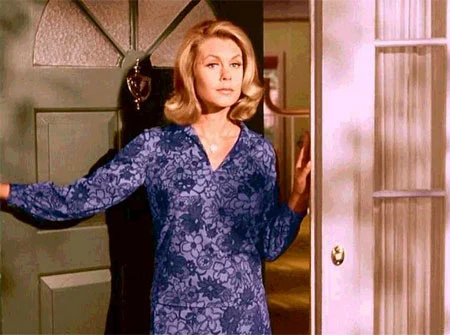When audiences think of television magic, one image often springs to mind: a blonde witch with twinkling eyes, a mischievous smile, and a twitch of her nose that could summon spells or dissolve trouble. That witch, of course, was Samantha Stephens, the iconic character brought to life by Elizabeth Montgomery. But while Bewitched secured Montgomery’s place in pop culture, her journey stretched far beyond the enchanted suburban home that millions visited through their television screens.
Born Into the Spotlight
Elizabeth Montgomery entered the world on April 15, 1933, in Los Angeles, California. Her birthright carried the weight of legacy. She was the daughter of Robert Montgomery, a respected film star and director, and Elizabeth Allen, an actress. The stage was set before she could walk; Hollywood was the family’s second language. Surrounded by scripts, cameras, and the cadence of performance, it was only natural that Elizabeth would one day step into the limelight herself.
Her early career mirrored the trajectory of many aspiring actors of the time. She appeared in guest roles on television, honing her craft with each performance. Yet, unlike some who leaned heavily on family connections, Elizabeth carved her own space through dedication. Her talent wasn’t inherited—it was cultivated.
The Bewitching Breakthrough
The role that would define her career arrived in 1964 with Bewitched, a sitcom that blended whimsical fantasy with domestic comedy. As Samantha Stephens, Montgomery embodied a character both magical and deeply human. Samantha was a witch who had fallen in love with a mortal man, Darrin, played first by Dick York and later by Dick Sargent. She wanted nothing more than to live a normal suburban life, yet her powers often complicated even the simplest of days.
Each episode played with the tension between the ordinary and the extraordinary: a burned roast rescued by a spell, a nosy neighbor peeking through curtains, or a magical mishap that turned houseguests into rabbits. But at the heart of the comedy was Montgomery herself. Her wit, elegance, and warmth turned Samantha into more than just a character—she became a symbol of charm and resilience.
Montgomery’s nose twitch, improvised in part by camera trickery and her playful gestures, became instantly iconic. Children imitated it on playgrounds. Adults smiled at the mixture of fantasy and familiarity. Through it all, audiences didn’t just see a witch—they saw Elizabeth, enchanting them with her performance.
Beyond Samantha
While Bewitched ran for eight successful seasons, ending in 1972, Elizabeth Montgomery was determined not to be confined by one role. She branched into television movies and stage productions, choosing projects that often carried more weight than sitcom laughs.
In the 1970s and 80s, she played against type in dramatic roles. Films such as The Legend of Lizzie Borden (1975) showcased her capacity for depth and darkness. In portraying the accused murderer, Montgomery left behind Samantha’s sunny suburban kitchen and stepped into chilling, complicated territory. Critics praised her courage to embrace characters so far removed from her most famous role.
Her range also extended into issue-driven television movies. She took roles that shed light on subjects like sexual assault, domestic abuse, and social injustice. At a time when television was still seen largely as escapism, Montgomery used it as a platform for storytelling that mattered.
A Woman of Conviction
Off-screen, Montgomery’s passions reflected her empathy. She was an outspoken advocate for causes close to her heart. She championed women’s rights, AIDS research, and social justice at a time when celebrities often remained silent on divisive issues. Her activism was not performative—it was persistent.
Those who knew her described her as compassionate, approachable, and fiercely committed. The same warmth that made Samantha Stephens beloved seemed to echo in Montgomery’s real-life dedication to others.
A Complex Star
Elizabeth Montgomery’s personal life often drew as much attention as her professional one. She married four times, navigating relationships under the public’s watchful eye. Yet through triumphs and heartbreaks, she continued to evolve as an actress and as a woman.
Her children often recalled her as a loving, involved mother who balanced the demands of Hollywood with the intimacy of family life. While her fame was undeniable, she remained grounded, prioritizing her values and the people she cared for.
Enduring Legacy
Elizabeth Montgomery’s career spanned decades, but her death in 1995 from cancer left fans and colleagues mourning a star who had given so much of herself on-screen and off. Yet her legacy has not dimmed. Bewitched continues to air in reruns, introducing new generations to Samantha Stephens and that unforgettable twitch of the nose.
For many, the show represents a golden era of television—light, funny, and charming. But for those who look deeper into Montgomery’s career, she symbolizes more than nostalgia. She represents the ability to embrace a beloved role without being trapped by it, to take risks with challenging parts, and to use fame as a force for good.
More Than Magic
Elizabeth Montgomery’s story is a reminder that behind every iconic character lies a real person—complex, talented, and human. While Samantha Stephens will forever sparkle in television history, Elizabeth’s true magic was her refusal to stop at one success. She sought growth, diversity, and meaning in her roles. She used her platform not only to entertain but to advocate.
Even now, nearly thirty years after her passing, fans continue to celebrate her not simply for the spells Samantha cast but for the grace Elizabeth embodied in her life and career.
She was, and remains, more than a witch with a twitch. She was a woman of conviction, an actress of remarkable range, and a star who understood that the truest kind of magic lies in touching lives—on the screen and beyond.
